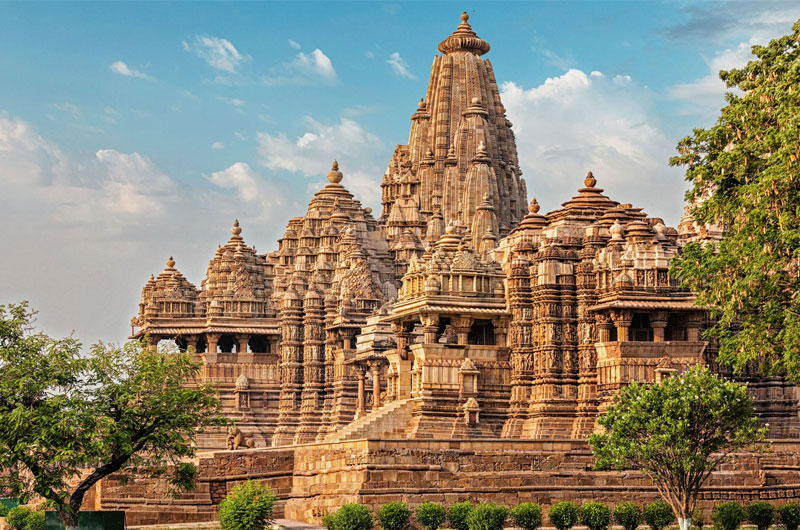
Khajuraho: The Erotic Temples of India – A World Heritage Site
The Khajuraho Group of Monuments, a UNESCO World Heritage Site, is a collection of Hindu and Jain temples located in Madhya Pradesh, India. Renowned for their stunning architecture and intricate erotic sculptures, these temples were built between 950 and 1050 CE by the Chandela dynasty. Khajuraho is a testament to the architectural and artistic excellence of medieval India, drawing tourists and scholars from around the globe.
Historical Background
- Origins and Construction
- Constructed by the Chandela dynasty between the 10th and 12th centuries.
- Originally comprised 85 temples, of which 25 survive today.
- Represents a significant period in the history of Indian art and architecture.
- Cultural and Religious Significance
- Temples dedicated to Hindu deities like Shiva, Vishnu, and Devi, as well as Jain Tirthankaras.
- Reflects the religious tolerance and diversity of the Chandela period.
Architectural Marvel
- Design and Structure
- Built from sandstone without the use of mortar, with the stones held together by gravity.
- Temples are set on high platforms and are known for their tall spires (shikharas) that symbolize the Himalayan peaks.
- Notable Temples
- Kandariya Mahadeva Temple: The largest and most ornate temple dedicated to Lord Shiva, with over 800 sculptures.
- Lakshmana Temple: Dedicated to Vishnu, known for its intricate carvings and harmonious proportions.
- Vishvanatha Temple: Another prominent Shiva temple, showcasing a blend of beauty and craftsmanship.
- Chausath Yogini Temple: The oldest surviving temple in Khajuraho, dedicated to the 64 Yoginis, goddesses of the tantric tradition.
- Parsvanatha Temple: The largest Jain temple at Khajuraho, known for its detailed sculptures of Jain Tirthankaras.
- Artistic Excellence
- Famous for their erotic sculptures, which make up a small fraction of the overall carvings.
- Depict various aspects of life, including gods, goddesses, musicians, warriors, and mythical creatures.
- Erotic art interpreted as a symbol of divine union and cosmic harmony.
Specialty of Khajuraho
- Erotic Sculptures
- Represent the celebration of love, life, and creation.
- Symbolize the Tantric practices and the acceptance of sexuality in the spiritual realm.
- Architectural Brilliance
- Exemplifies Nagara-style architecture with intricate carvings and harmonious design.
- Temples are meticulously planned with symmetrical layouts and exquisite detail.
- Cultural Significance
- Reflects the social and cultural milieu of the Chandela period.
- Demonstrates the artistic and architectural zenith of the period.
Tourism Aspects
- Visitor Experience
- Guided tours available in multiple languages.
- Light and sound show that narrates the history of Khajuraho.
- Well-maintained pathways and interpretive signage for a comfortable visit.
- Nearby Attractions
- Raneh Falls: A picturesque waterfall on the Ken River, located about 20 kilometers from Khajuraho.
- Panna National Park: A wildlife sanctuary known for its tigers, leopards, and rich biodiversity, located nearby.
- Ken Gharial Sanctuary: A conservation area for gharials and other aquatic animals, located close to the Raneh Falls.
- Events and Festivals
- Khajuraho Dance Festival: An annual festival held in February/March, celebrating classical Indian dance forms against the backdrop of the temples.
- Makar Sankranti: A local festival marked by kite flying and cultural events.
Impact on Locality
- Economic Significance
- Major contributor to the local economy through tourism.
- Provides employment opportunities for local guides, artisans, and vendors.
- Cultural Influence
- Enhances community pride and historical awareness.
- Promotes the preservation of traditional crafts and cultural heritage.
Preservation and Challenges
- Conservation Efforts
- Managed by the Archaeological Survey of India (ASI).
- Ongoing restoration and maintenance to preserve the structural integrity and artistic value.
- Environmental Concerns
- Impact of weathering and environmental degradation.
- Measures to control visitor impact and ensure sustainable tourism practices.
Conclusion
The Khajuraho Group of Monuments stands as a monumental testament to the artistic and architectural brilliance of medieval India. As a UNESCO World Heritage Site, it not only attracts tourists and scholars worldwide but also underscores the rich cultural heritage of India. The ongoing efforts to preserve and protect these iconic temples ensure that they continue to inspire awe and admiration for generations to come.
